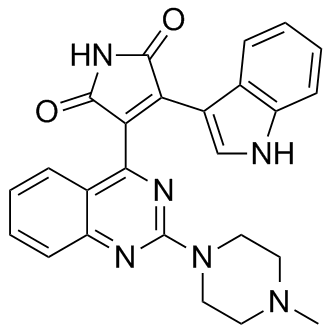| Description: |
Sotrastaurin is a potent pan-PKC inhibitor, with Kis of 0.22 nM, 0.64nM, 0.95 nM, 1.8 nM, 2.1 nM and 3.2 nM for PKCθ, PKCβ, PKCα, PKCη, PKCδ and PKCε, respectively. |
| In Vivo: |
The combination therapy results in a significantly enhanced reduction in tumor volume when compared to either Sotrastaurin (AEB071) or BYL719 alone (p=0.049 vs. BYL719 and p=0.022 vs. Sotrastaurin at day 26). There is even a greater effect when compared to vehicle control (p=0.016)[2]. Sotrastaurin (STN) treatment of liver donors and orthotopic liver transplantation (OLT) recipients (Gr.I) or of OLT recipients alone (Gr.II) prolongs animal survival, as 9 out of 10 rats in Gr. I, and 6 out of 6 rats in Gr.II survive >14 days. In contrast, only 4 out of 10 control OLT recipients remain alive at day 14 (p<0.01)[3]. |
| In Vitro: |
In cell-free kinase assays Sotrastaurin (AEB071) inhibits PKC, with Ki values in the subnanomolar to low nanomolar range. When Sotrastaurin is tested on a selected panel of kinases, the only enzyme on which Sotrastaurin displays an IC50value below 1 μM is glycogen synthase kinase 3β[1]. Sotrastaurin (AEB071) inhibits p-MARCKS, a PKC substrate, and pS6 in all the cell lines, independently of the mutational status. There is a slight inhibition of pERK at lower doses also in the GNA11 mutant cells, but not in the WT cells at any concentrations. This is consistent with previous reports indicating that Sotrastaurin inhibits ERK1/2 phosphorylation in GNAQ mutant cell lines[2]. |






















